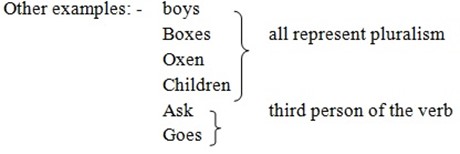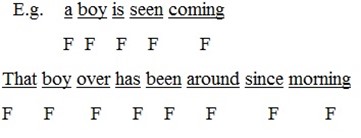This is the field or branch of morphology which studies different principles or processes which govern the conservation or formation of words in a particular language. I.e. it refers to the processes by which new words are formed or built in a particular language.
This process involves morphological processes (then formation of words through combinations of morphemes together with other different processes.
The process of word formation may involve the process whereby roots or stems received inflectional or derivational element (affixes) in order to form the new words.
NB: The roots, stems inflectional or derivational elements are all technique termed as morphemes
MORPHOLOGY
This is a component of grammar (sub branch) of linguistics which deals with the study of morphemes and their difference forms (Allomorphs) and how these units combine together in the formation of words. It also studies the structure and arrangement of words in the dictionary i.e. Morphology is the study of word formation and dictionary use.
DEFINITIONS OF KEY WORDS
1. Morpheme
This is the smallest grammatical or lexical unit in the structure of a language which may form a word or part of a word
E.g. nation national
International
Internationally
Nationalization
Kind – kindness
Unkind
Unkindness
Take – takes
Taken
Taking
Discuss – discussion
Discussions
A morpheme may represent the lexical meaning or grammatical function.
2. Word
This is the minimal or smallest unit in the structure of a sentence in any language which may constitute on utterance or sentence on its own.
The word is usually formed by either one or several morphemes out it is the smallest unit in the sentence structure.
E.g. Yesterday I met him at Tabata- 6 words
We can words in a sentence and morphemes in a word
3. Stem
Is that part of a word that is in existence before any inflectional affixes have been added. Or
Is that part of the word that inflectional affixes can be attached to.
For example:- “cat” can take inflectional morpheme-‘S’
– “Worker” can take inflectional morpheme-‘S’
– “Winne” can take inflectional morpheme-‘S’
– “Short” can take inflectional morpheme-‘er’
– “friendship” can take inflectional morpheme-‘S’
NB:
- A stem is a root or roots of the word together with any derivation affixes to which inflectional affixes are added.
- A stem consists minimally of a root but may be analyzable word into a root plus derivation morphemes
edu.uptymez.com
4. Base
Is any unit whatsoever to which affixes of any kind can be added.
For example; in the word “playful”
‘play‘ is a root and also a base
In the word ‘playfulness‘ the root is still “play” but the base is ‘playful‘
– “Instruct” is the base for forming instruction, instructor and re-instruct
NB: All roots can be bases but not all bases are roots.
TASK
1. Write ten words which you think are bases but they are not roots
2. Identify the inflectional affixes, derivational affixes, roots, base and stems in the following words faiths, faithfully, unfaithful, faithfulness, bookshops, window-cleaners, hardships
5. Root
This is a basic part of a word which normally carries lexical meaning corresponding to the concept, object or idea and which cannot be split into further parts
Roots in many languages may also be joined to other roots or take affixes or combing forms
E.g. Man manly, house hold, big
6. Affix
This is a morpheme, usually grammatical which is attached to another morpheme (stem) in the formation of a new word which may change the meaning, grammatical category or grammatical form of the stem.
E.g. Beautiful mismanagement
Disconnect
The affix maybe added either before, with or after the stem thus are three types of affixes.
i. Prefix
This is the affix which is added before the stem
E.g. Disconnect
Illogical
Unhappy
Empower
ii. Infix
This is the affix that is added within the stem. Thus type of affix is rare to be found in English words
E.g. meno – meino
iii. Suffix
This is the affix that is added after the stem.
E.g. Mismanagement
Beautiful
Dismissal
Kingdom
7. Allomorph
This refers to any of the difference forms of the same morpheme root they all represent the past participle (grammatical function)

CLASSIFICATION OF MORPHEMES
The morphemes are classified into several categories basing on several factor such as:-
Occurrence, meaning and function
There are two major types of morphemes
(i) Free morpheme
This is the morpheme that can stand or occur alone (on its own) as a separate word in the structure of a sentences in any language.
The free morpheme includes all parts of speech i.e. Nouns, Verbs, adjectives, adverbs, pronouns, prepositions, conjunctions, interjections, articles

The free morpheme is further divided into two categories
(a) Lexical morpheme
This is the type of frees morpheme which occurs on its own and carries a content of the message being conveyed i.e. It is the free morpheme which represents the actual lexical meaning of the concept, idea, object or action.
The lexical morphemes include the major word classes such as Noun, verbs (main verb), adjective and adverb.
E.g. House
Attend
Large
Tomorrow
(b) Functional morpheme / grammatical morpheme
This is the free morpheme which can stand alone as a separate word in a sentence but does not represent the actual lexical meaning of the concept, idea, object or action – it has little meaning when used alone and thus it usually occurs together with the lexical morpheme in order to give the lexical meaning
The functional morphemes includes the minor word classes such as pronouns, prepositions, conjunctions, interjections and articles, auxiliary verbs etc

(ii) Bound morpheme
This is the morpheme which can not normally stand alone as a separate word in the sentence structure as it is attached to another morpheme (lexical) free morpheme in the formation of the new word.
The Bound morpheme represents grammatical function such as word category tense aspect, person, number, participle, comparison etc.
Example ment, ism represents a noun, aly represent.
Adverb
Tense – ed, d, voice, number
Person – es
Aspect – ing – progressive aspect
Comparison – er, est
The Bound morpheme is farther divided in to two categories.
(a) Derivation morpheme
This is the bound morpheme which is used to form or make new words with different meanings and grammatical categories or class from the stem i.e. It is the morpheme which when added to the stem it changes the meaning and / or the word class of grammatical category of stem/ base Example unhappy, illogical, impossible, empower
National – noun to adjective
Derivation morpheme may occur either before or after or both before and after the stem in the formation of the new words i.e. they may occur either as prefixes or affixes example management, mismanage, mismanagement.
The derivation morpheme may also change the sub classification of the same word class such as concrete noun into abstract noun e.g. Kingdom, friendship, leadership, membership
Deviation morphemes are also used as indicators of word category example simplicity, modernize dare indicators of verb by indicator of adverbs.
(b) Inflectional morpheme
This is the type of bound morpheme which is not used to produce or form different words with different meaning but rather it is used to change grammatical form of the state i.e. Inflectional morpheme doesn’t change the meaning or word class but it only changes grammatical form of the sentence which represent grammatical function such as to mark the verb for tense aspect, participle voice etc
Example finished, Lorries, oxen
Past tense – finished
Past participle – proven
Number – Lorries, oxen, children
Inflectional morpheme also marks nouns and number.
They mark adverb and adjectives for comparison
E.g. smaller, smallest
The inflectional morpheme occurs only after the stem (they are suffix)
FUNCTION OF MORPHEMES
The morphemes are analyzed as having three major functions that are directly linked with their types.
The following are the functions of morphemes: –
1. The morpheme (free morphemes) are used to form the bases or roots of the words i.e. a single free morpheme, lexical or functional forms the base or root of a word. This function is therefore called Base – form
function
E.g. Tree, after, along
2. The morphemes (derivation bound morphemes) are used to change the lexical meaning and / or the grammatical category of the stem. This function is called derivation function
E.g. Disunity, illegal, beautiful, quickly, modernize
3. The morphemes (inflectional morphemes) are used to change the grammatical form or function of the stem without changing the meaning or word class.
This function is known as inflectional function
E.g. goes, tallest
TASK
Read the following passage and answer the following question
A thick vegetation cover, such as tropical forests , acts as protection against physical weathering and also helps to slow the removal of the weathered layer in deserts and high mountains the absence of the vegetation accelerates the rate of weathering plants and animals, however, play a significant part in rock destruction, notably by chemical decomposition through the action of organic acidic solution the acids develop from water percolation through party decayed vegetation and animal matter.
Question
1. Identify
I. 7 lexical morphemes
II. 5 derivation morphemes
III. 2 inflectional morphemes